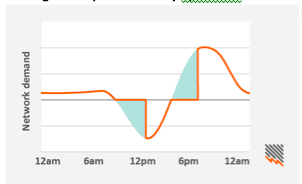SA Power Networks, currently running the largest residential battery storage trial in the country, says its early finding suggest that battery storage devices are not configured to help reduce network peaks. In fact, in some ways they may be making the situation worse.
SAPN last year installed 100 batteries in customer premises in the city of Salisbury, in what is the largest virtual power plant installed to date, and is now getting some early results from the three-year trial.
The most dramatic finding is represented in this graph below. It shows how solar affects grid demand and what happens when battery storage is added. Rather than smoothing out the peaks, it can actually make the “ramp up” periods more abrupt.
According to Mark Vincent, SAPN’s head of network investment strategy and planning, this is not a good outcome.
Vincent told RenewEconomy during a recent visit to SAPN’s innovation centre in Adelaide that it underlines the need for new algorithms to be put in place to change the behaviour of battery storage devices so it takes the peaks – both bottom and low.
This is how we would like it to look (bottom graph below). And he repeats SAPN’s push for a demand tariffs to provide the market signals to help that happen. Without a properly calibrated demand tariff, the peak might be clipped, but the bottom won’t be (top graph below). Both are important to address.
Battery storage will be crucial for the SA network, because the state has traditionally had the highest volatility, and with the introduction of more wind and solar, will reduce its dependence on traditional fossil fuel plants.
That leaves battery storage to play a crucial role in meeting peak demand and providing grid stability, and SAPN hopes that it will help offset further investment in new poles and wires or equipment upgrades.
Already, the state has 650MW of rooftop solar, accounting for nearly 6 per cent of its demand in 2015/16, and within a decade the output of rooftop solar is expected to be more than minimum demand in the state.
“We expect installation of solar to keep progressing and an accelerating uptake of battery storage as prices fall in coming years,” Vincent said in a recent staff newsletter than revealed the findings.
“Integrating batteries and solar PV is very attractive for us because, on hot summer days, peak demand on the network in residential areas occurs during the 6 PM to 9 PM period when solar generation has reduced.
“Charging batteries during periods when energy would otherwise be exported into the grid, should mean that energy is available for discharge during periods of peak demand or high supply cost.”
Vincent says that the way battery management software is currently configured, a solar PV/battery combination “doesn’t help us sufficiently in managing the peak, nor does it help with the forecast trend of PV exports exceeding demand in SA in the early afternoon.”
“To maximise the benefits of solar PV/battery installations, smarter algorithms in battery management software are needed to slow down the rate of charging of the batteries and their rate of energy discharge so we can lop off the demand and generation peaks.
“In turn, we need to make sure that our tariffs are designed to encourage battery vendors to configure their systems in this way, and so that customers will also see a benefit.
“Without those changes to the configuration of batteries so that they charge and discharge in smarter ways, widespread uptake of batteries has the potential to lead to inefficiencies that will require a significant response from us as distribution network managers.”
SAPN says that while it “doesn’t make financial sense” for most customers to invest in batteries just yet – contrary to some private estimates – it admits that prices are reducing rapidly.
“We think it’s inevitable that customers will invest more and more in battery systems. Our challenge is to make sure that they operate these systems in ways that reduce and don’t increase network costs to all customers.”












